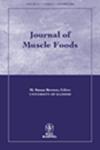THE INFLUENCE OF SEASON ON LIPID CONTENT AND FATTY ACIDS PROFILE OF EUTHYNNUS ALLETTERATUS FILLETS AND BY-PRODUCTS
Abstract
ABSTRACT
The seasonal lipid variation and fatty acids compositions were assessed in white and red muscles, head, viscera, liver and gonads of little tuna Euthynnus alletteratus. Lipid contents showed a significant variation (P < 0.05) throughout the year, the maximum level was found in the liver during winter season (27.28 g/100 g). The lowest fat contents were found in gonads during the winter and spring seasons, with levels of 1.56 and 1.49 g/100 g, respectively. White and red muscle fat levels increased significantly from winter to summer; viscera lipids, however, showed a significant decrease during the same period. Generally, the increase of the polyunsaturated fatty acids percentage in most organs was usually accompanied with a decrease of saturated fatty acids. It was shown that lipid content was higher in the head and liver compared to other compartments, and the fatty acid composition in the different organs of little tuna was significantly influenced by spawning and season. All lipids extracted contained significant amounts of docosahexaenoic acid and eicosapentaeneoic acid, which have various physiological functions.
PRACTICAL APPLICATIONS
Most of the available literature showed little information about biochemical composition of fillets and by-products of some fish species and are, therefore, not complete for industrial purposes as application in food or feed nutriment. The practical application of this study was performed by the determination of fatty acids levels of little tuna fillets (white and red muscles) and by-products (head, viscera, liver and gonads) to further explain the evolution of lipid and fatty acids throughout the year. Finally, this manuscript may provide some valuable information for other scientists working in the field of food technology.

 求助内容:
求助内容: 应助结果提醒方式:
应助结果提醒方式:


